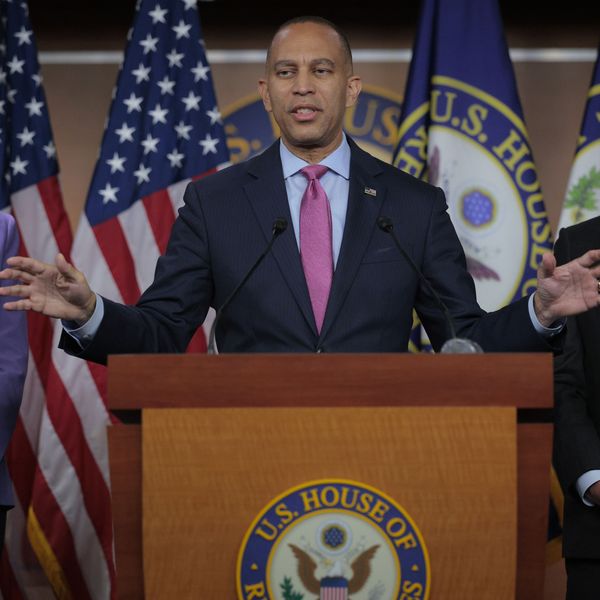Faced with an overabundance of underused coal plants, what has today's coal industry decided to do?
Keep on building new coal plants--to the tune of a whopping $981 billion.
Those are the findings of a new report (pdf) put out by environmental groups Greenpeace, the Sierra Club, and CoalSwarm. "New investigations detailed in the report revealed that while the coal industry continues to push for the construction of more coal-fired power plants, in reality, coal plants are increasingly sitting idle in all of the world's four largest markets, and global coal consumption is declining drastically," the groups noted in a press statement.
The non-profits' report, Boom and Bust 2016: Tracking The Global Coal Plant Pipeline, explores the perplexing trend:
The world has too many coal-fired power plants, yet the power industry continues to build more. While the amount of electricity generated from coal has declined for two years in a row, the industry has ignored this trend and continues to build new coal-fired generating plants at a rapid pace, creating an increasingly severe capacity bubble. The problem of over-capacity is especially pronounced in China, where the average coal plant is now run at a 49.4 percent rate, less than half its full capacity. Meanwhile, 338 GW of new coal capacity is in construction worldwide, and 1,086GW is in various stages of planning--the equivalent of 1,500 coal plants. The amount of overspending on these potentially unneeded plants amounts to US$981 billion, or close to one trillion dollars.
"Coal use keeps falling off a cliff and plants are sitting idle, yet more money is being wasted on misguided attempts at locking in this dirty, dangerous fuel," said Nicole Ghio, senior campaigner for the Sierra Club's International Climate and Energy campaign. "The hundreds of billions being thrown at coal could instead go toward the booming clean energy sector, helping more than a billion people get access to the clean, reliable electricity that fossil fuels have failed to deliver."
China in particular is struggling to fight a looming overcapacity problem. "China alone is housing the largest power market investment bubble the world has ever seen," observed Lauri Myllyvirta, senior global campaigner on Coal and Air Pollution at Greenpeace.
In fact, the country's coal consumption and output are both projected to fall by 2 percent, according to the Australia Financial Review. In an effort to combat the bubble, the government last week ordered the construction of 250 coal plants to be halted and suspended permits for new coal plants in 13 provinces.
But even after those sweeping changes take effect, Myllyvirta noted that "the country could still bring over 500 new coal-fired power plant units online while power generation from coal is falling precipitously on clean energy growth and slower power demand."
And unfortunately coal "still accounts for the bulk of Chinese electricity generation, and will probably continue to do so for years, if not decades, to come, because power plants can operate for half a century," Foreign Policy reported last week.
The news wasn't all bad: the report discovered that 2015 "saw India's first drop in annual [coal project] installations after continuing growth since 2006," and its authors predict an even steeper drop in 2016 in that country. In fact, the report observes that around the world, coal plants are shuttering at a record pace--led by closings in the U.S. and Europe.
"In the United States, we've hit the point where coal is in a structural decline, and I think globally we are getting there as well," Maura Cowley, director of the international climate and clean energy campaign for the Sierra Club, told Foreign Policy last week.
Last week marked the closure of the last remaining coal plant in Scotland, and earlier this month the last coal mine in the U.K. was permanently sealed. And in the past several months, the American coal industry was dealt harsh blows with announcements of pending bankruptcies for two of the country's largest coal companies, Arch and Peabody Coal, pointing to the severe financial risks of investing in coal today.
So why are some investors still funneling so much money into coal projects around the world?
"Much of today's overbuilding," the report says, "is defended on the claims that newer plants are more efficient than older ones. However, even adding so-called efficient plants is counterproductive because it locks in large, long-lived carbon emitters, interfering with the need to fully decarbonize the power sector by 2040 in order to limit warming to 2degC."
Even without an additional $1 trillion worth of new coal projects, the report warns that "emissions from current coal plants will still be 150 percent higher than what is consistent with scenarios limiting warming to 2degC--meaning that most operating and new coal-fired plants will have to be phased out well before the end of their planned lifetime."
Indeed, while "this research has revealed hundreds of billions being squandered on unneeded coal plants, there's more at stake here than money," as CoalSwarm director Ted Nace argued. "In terms of climate safety, the clock is ticking on the transition to clean energy. There is no time to waste."


